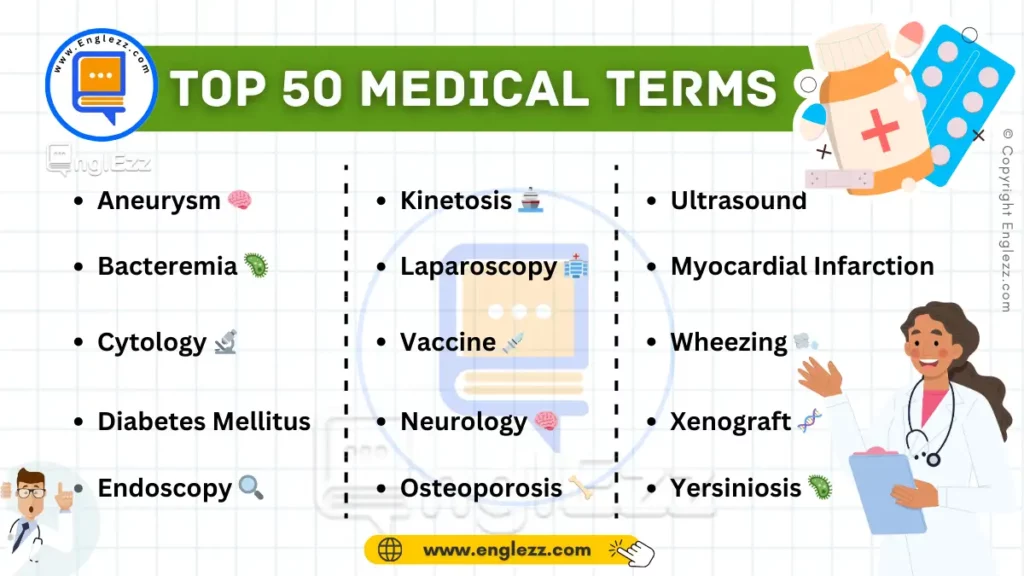Understanding medical terminology is crucial for students in the healthcare field. Mastery of medical English terms not only aids in effective communication but also enhances the ability to grasp complex concepts and provide quality patient care. In the ever-evolving world of medicine, having a solid foundation in medical vocabulary is essential. This blog post presents 50 must-know medical English terms, complete with definitions, phonetic transcriptions, and practical examples.
Table of Contents
- 50 Medical English Terms Every Student Must Know
- #1. Aneurysm 🧠
- #2. Bacteremia 🦠
- #3. Cytology 🔬
- #4. Diabetes Mellitus 🍭
- #5. Endoscopy 🔍
- #6. Febrile 🌡️
- #7. Gastroenteritis 🤢
- #8. Hemoglobin 🩸
- #9. Immunocompromised 🛡️
- #10. Jaundice 🌟
- #11. Kinetosis 🚢
- #12. Laparoscopy 🏥
- #13. Myocardial Infarction ❤️
- #14. Neurology 🧠
- #15. Osteoporosis 🦴
- #16. Pneumonia 🌬️
- #17. Quadriplegia 🧑🦽
- #18. Rheumatoid Arthritis 🤕
- #19. Sepsis 🚨
- #20. Tachycardia 💓
- #21. Ultrasound 📡
- #22. Vaccine 💉
- #23. Wheezing 🌬️
- #24. Xenograft 🧬
- #25. Yersiniosis 🦠
- #26. Zoonosis 🦟
- #27. Anaphylaxis ⚠️
- #28. Bronchitis 🌬️
- #29. Cholecystitis 🏥
- #30. Dysphagia 🥄
- #31. Eczema 🧴
- #32. Fibromyalgia 💥
- #33. Glaucoma 👁️
- #34. Hematoma 🩹
- #35. Inflammation 🔥
- #36. Jaundice 🌟
- #37. Keratosis 👋
- #38. Leukemia 🩸
- #39. Melanoma 🌑
- #40. Nausea 🤢
- #41. Osteoarthritis 🦵
- #42. Pneumothorax 🌬️
- #43. Quarantine 🚪
- #44. Rash 🌿
- #45. Seizure ⚡
- #46. Tinnitus 🔔
- #47. Ulcer 🩹
- #48. Vertigo 🌪️
- #49. Wound 🩹
- #50. X-ray 🩺
- Medical English Terms Table
- Conclusion
50 Medical English Terms Every Student Must Know
Whether you are a medical student, a healthcare professional, or someone interested in medical terminology, this guide will equip you with the essential knowledge needed to excel. Each term is carefully selected to ensure it covers a broad range of medical fields and concepts, making this resource invaluable for anyone aiming to succeed in the medical profession.
#1. Aneurysm 🧠
Definition: A localized enlargement of an artery caused by a weakening of the artery wall.
Phonetic Transcription: ˈæn.jə.rɪz.əm
Examples:
- An aneurysm in the brain can lead to a stroke if it ruptures.
- Regular imaging is required to monitor the size of an aneurysm.
#2. Bacteremia 🦠
Definition: The presence of bacteria in the blood.
Phonetic Transcription: ˌbæk.təˈriː.mi.ə
Examples:
- Bacteremia can be a complication of infections like pneumonia.
- Blood cultures are used to diagnose bacteremia.
#3. Cytology 🔬
Definition: The branch of biology concerned with the structure and function of plant and animal cells.
Phonetic Transcription: saɪˈtɒl.ə.dʒi
Examples:
- Cytology is crucial for diagnosing cancer through cell samples.
- A Pap smear is a cytology test used to detect cervical cancer.
#4. Diabetes Mellitus 🍭
Definition: A group of diseases that affect how the body uses blood sugar (glucose).
Phonetic Transcription: ˌdaɪ.əˈbiː.tiːz ˈmel.ɪ.təs
Examples:
- Type 1 diabetes mellitus is an autoimmune condition.
- Monitoring blood sugar levels is essential for managing diabetes mellitus.
#5. Endoscopy 🔍
Definition: A procedure using an endoscope to examine the interior of a hollow organ or cavity.
Phonetic Transcription: ˌen.dəˈskɒp.i
Examples:
- Endoscopy is used to view the gastrointestinal tract.
- It helps in diagnosing conditions like ulcers and tumors.

#6. Febrile 🌡️
Definition: Relating to or characterized by fever.
Phonetic Transcription: ˈfeb.raɪl
Examples:
- A febrile patient often exhibits a high body temperature.
- Febrile seizures can occur in young children with high fever.
#7. Gastroenteritis 🤢
Definition: Inflammation of the stomach and intestines, often due to infection.
Phonetic Transcription: ˌɡæs.trəʊˌen.təˈraɪ.tɪs
Examples:
- Gastroenteritis can cause vomiting and diarrhea.
- Proper hydration is essential during an episode of gastroenteritis.
#8. Hemoglobin 🩸
Definition: A protein in red blood cells that carries oxygen throughout the body.
Phonetic Transcription: ˌhiː.məˈɡləʊ.bɪn
Examples:
- Hemoglobin levels are measured to diagnose anemia.
- Abnormal hemoglobin can indicate various blood disorders.
#9. Immunocompromised 🛡️
Definition: Having an impaired or weakened immune system.
Phonetic Transcription: ˌɪm.jʊ.nəʊˈkɒm.prə.maɪzd
Examples:
- Patients undergoing chemotherapy are often immunocompromised.
- Immunocompromised individuals are at higher risk for infections.
#10. Jaundice 🌟
Definition: A yellowing of the skin and eyes due to excess bilirubin in the blood.
Phonetic Transcription: ˈdʒɔːn.dɪs
Examples:
- Jaundice is commonly seen in newborns with liver issues.
- It can be a sign of liver disease or a bile duct obstruction.
#11. Kinetosis 🚢
Definition: A condition characterized by dizziness and nausea during motion.
Phonetic Transcription: ˌkɪn.ɪˈtəʊ.sɪs
Examples:
- Kinetosis is often experienced during travel by car or boat.
- Medications can help alleviate symptoms of kinetosis.
#12. Laparoscopy 🏥
Definition: A minimally invasive surgical procedure using a laparoscope to view the abdominal organs.
Phonetic Transcription: ˌlæp.əˈrɒs.kə.pi
Examples:
- Laparoscopy is used for gallbladder removal.
- It results in smaller incisions and quicker recovery compared to open surgery.
#13. Myocardial Infarction ❤️
Definition: A medical term for a heart attack, caused by the blockage of blood flow to the heart muscle.
Phonetic Transcription: ˌmaɪ.əʊˈkɑː.di.əl ɪnˈfɑːk.ʃən
Examples:
- Symptoms of myocardial infarction include chest pain and shortness of breath.
- Immediate medical attention is required to treat a myocardial infarction.
#14. Neurology 🧠
Definition: The branch of medicine dealing with disorders of the nervous system.
Phonetic Transcription: njʊˈrɒl.ə.dʒi
Examples:
- Neurology involves the study of brain disorders like epilepsy.
- Neurologists diagnose and treat conditions such as multiple sclerosis.
#15. Osteoporosis 🦴
Definition: A condition characterized by weakened bones, increasing the risk of fractures.
Phonetic Transcription: ˌɒs.ti.əʊ.pəˈrəʊ.sɪs
Examples:
- Osteoporosis is common in older adults, particularly women.
- Weight-bearing exercises can help strengthen bones affected by osteoporosis.
#16. Pneumonia 🌬️
Definition: An infection that inflames the air sacs in one or both lungs.
Phonetic Transcription: njuːˈməʊ.ni.ə
Examples:
- Pneumonia can be caused by bacteria, viruses, or fungi.
- Symptoms include cough, fever, and difficulty breathing.
#17. Quadriplegia 🧑🦽
Definition: Paralysis affecting all four limbs due to spinal cord injury.
Phonetic Transcription: ˌkwɒd.rɪˈpliː.dʒə
Examples:
- Quadriplegia may result from a severe spinal cord injury.
- Rehabilitation is crucial for managing quadriplegia and improving quality of life.
#18. Rheumatoid Arthritis 🤕
Definition: An autoimmune disorder that primarily affects joints, causing inflammation and pain.
Phonetic Transcription: ˌruː.mə.tɔɪd ɑːˈθraɪ.tɪs
Examples:
- Rheumatoid arthritis can cause joint deformities over time.
- Early diagnosis and treatment can help manage symptoms of rheumatoid arthritis.
#19. Sepsis 🚨
Definition: A life-threatening condition resulting from the body’s response to infection, leading to widespread inflammation.
Phonetic Transcription: ˈsɛp.sɪs
Examples:
- Sepsis can cause organ failure and requires prompt medical treatment.
- Symptoms include fever, rapid heart rate, and confusion.
#20. Tachycardia 💓
Definition: An abnormally rapid heart rate, typically over 100 beats per minute.
Phonetic Transcription: ˌtæk.i.kɑːˈdɪə
Examples:
- Tachycardia can be caused by stress, fever, or heart conditions.
- It is important to determine the underlying cause of tachycardia.
#21. Ultrasound 📡
Definition: An imaging technique using high-frequency sound waves to create pictures of the inside of the body.
**Phonetic
Transcription:** ˈʌl.trə.saʊnd
Examples:
- Ultrasound is commonly used to monitor fetal development during pregnancy.
- It helps in diagnosing conditions such as tumors and cysts.
#22. Vaccine 💉
Definition: A biological preparation that provides immunity to a specific disease.
Phonetic Transcription: ˈvæk.siːn
Examples:
- Vaccines are crucial in preventing infectious diseases like measles and influenza.
- Routine vaccinations are essential for maintaining public health.
#23. Wheezing 🌬️
Definition: A high-pitched whistling sound made while breathing, typically indicating obstruction in the airways.
Phonetic Transcription: ˈwiː.zɪŋ
Examples:
- Wheezing is often associated with asthma or chronic obstructive pulmonary disease (COPD).
- A bronchodilator can help relieve wheezing by opening the airways.
#24. Xenograft 🧬
Definition: A transplant of tissue or organs from one species to another.
Phonetic Transcription: ˈzen.əʊˌɡræft
Examples:
- Xenografts are used in experimental treatments for organ transplants.
- Common sources for xenografts include pigs and cows.
#25. Yersiniosis 🦠
Definition: An infection caused by the bacterium Yersinia, leading to gastrointestinal symptoms.
Phonetic Transcription: jɜːrˌsɪn.iˈəʊ.sɪs
Examples:
- Yersiniosis can cause fever, abdominal pain, and diarrhea.
- It is often contracted through contaminated food or water.
#26. Zoonosis 🦟
Definition: A disease that can be transmitted from animals to humans.
Phonetic Transcription: zuːˈnəʊ.sɪs
Examples:
- Zoonosis includes diseases like rabies and Lyme disease.
- Preventing zoonosis involves avoiding contact with infected animals.
#27. Anaphylaxis ⚠️
Definition: A severe, potentially life-threatening allergic reaction.
Phonetic Transcription: ˌæn.ə.fɪˈlæks.ɪs
Examples:
- Anaphylaxis can be triggered by food allergies or insect stings.
- Immediate administration of epinephrine is required to treat anaphylaxis.
#28. Bronchitis 🌬️
Definition: Inflammation of the bronchial tubes, often due to infection.
Phonetic Transcription: ˌbrɒŋˈkaɪ.tɪs
Examples:
- Bronchitis causes a persistent cough and mucus production.
- It can be acute or chronic, with chronic bronchitis linked to smoking.
#29. Cholecystitis 🏥
Definition: Inflammation of the gallbladder, usually due to gallstones.
Phonetic Transcription: ˌkəʊ.ləˌsɪsˈtaɪ.tɪs
Examples:
- Cholecystitis can cause severe abdominal pain and nausea.
- Treatment may involve medication or surgical removal of the gallbladder.
#30. Dysphagia 🥄
Definition: Difficulty or discomfort in swallowing.
Phonetic Transcription: dɪsˈfeɪ.dʒə
Examples:
- Dysphagia can be caused by conditions such as stroke or esophageal cancer.
- Swallowing therapy and dietary changes can help manage dysphagia.
#31. Eczema 🧴
Definition: A condition that makes the skin red, inflamed, and itchy.
Phonetic Transcription: ˈɛk.zə.mə
Examples:
- Eczema is often treated with topical corticosteroids.
- Moisturizers and avoiding irritants can help manage eczema symptoms.
#32. Fibromyalgia 💥
Definition: A chronic condition characterized by widespread muscle pain and fatigue.
Phonetic Transcription: ˌfaɪ.brəʊˈmaɪ.əl.dʒə
Examples:
- Fibromyalgia can also cause sleep disturbances and mood issues.
- Treatment includes medication, exercise, and stress management.
#33. Glaucoma 👁️
Definition: A group of eye conditions that damage the optic nerve, often associated with high intraocular pressure.
Phonetic Transcription: ɡlæʊˈkəʊ.mə
Examples:
- Glaucoma can lead to vision loss if not treated early.
- Regular eye exams are crucial for detecting glaucoma.
#34. Hematoma 🩹
Definition: A localized collection of blood outside of blood vessels, typically due to trauma.
Phonetic Transcription: ˌhiː.məˈtəʊ.mə
Examples:
- Hematomas can occur in the brain following a head injury.
- Treatment may involve monitoring or surgical intervention if severe.
#35. Inflammation 🔥
Definition: A response by body tissues to injury or infection, characterized by redness, heat, swelling, and pain.
Phonetic Transcription: ˌɪn.fləˈmeɪ.ʃən
Examples:
- Inflammation is a common feature of conditions like arthritis.
- Anti-inflammatory medications can help reduce inflammation.
#36. Jaundice 🌟
Definition: A condition characterized by yellowing of the skin and eyes due to high levels of bilirubin in the blood.
Phonetic Transcription: ˈdʒɔːn.dɪs
Examples:
- Jaundice in newborns is often due to immature liver function.
- It can also indicate liver disease in adults.
#37. Keratosis 👋
Definition: A growth of keratin on the skin or mucous membranes.
Phonetic Transcription: ˌker.əˈtəʊ.sɪs
Examples:
- Keratosis can appear as rough patches or bumps on the skin.
- Treatment may involve topical medications or cryotherapy.
#38. Leukemia 🩸
Definition: A type of cancer that affects the blood and bone marrow, leading to the production of abnormal white blood cells.
Phonetic Transcription: luːˈkiː.mi.ə
Examples:
- Leukemia can cause symptoms such as fatigue and frequent infections.
- Treatment often involves chemotherapy or bone marrow transplants.
#39. Melanoma 🌑
Definition: A serious form of skin cancer that originates in the melanocytes, the cells that produce pigment.
Phonetic Transcription: ˌmel.əˈnəʊ.mə
Examples:
- Melanoma may appear as an irregularly shaped mole.
- Early detection through skin checks can improve treatment outcomes.
#40. Nausea 🤢
Definition: A sensation of unease and discomfort in the stomach with an urge to vomit.
Phonetic Transcription: ˈnɔː.zi.ə
Examples:
- Nausea can be caused by motion sickness or gastrointestinal issues.
- Anti-nausea medications and dietary changes can provide relief.
#41. Osteoarthritis 🦵
Definition: A degenerative joint disease characterized by the breakdown of cartilage.
Phonetic Transcription: ˌɒs.ti.əʊ.ˈɑːθ.raɪ.tɪs
Examples:
- Osteoarthritis often affects the knees, hips, and hands.
- Physical therapy and medications can help manage symptoms.
#42. Pneumothorax 🌬️
Definition: A condition where air enters the pleural space between the lung and chest wall, causing lung collapse.
Phonetic Transcription: ˌnjuː.məʊˈθɔː.ræks
Examples:
- Pneumothorax can occur spontaneously or due to trauma.
- Treatment may involve inserting a chest tube to remove the air.
#43. Quarantine 🚪
Definition: The separation and restriction of movement of people exposed to a contagious disease to prevent its spread.
Phonetic Transcription: ˈkwɔːr.ən.tiːn
Examples:
- Quarantine measures were used to control the spread of COVID-19.
- Quarantine protocols help prevent outbreaks in healthcare settings.
#44. Rash 🌿
Definition: A change in the skin that affects its color, appearance, or texture, often due to irritation or infection.
Phonetic Transcription: ræʃ
Examples:
- A rash can be a symptom of allergic reactions or infections.
- Identifying the cause of a rash is key to effective treatment.
#45. Seizure ⚡
Definition: A sudden surge of electrical activity in the brain that causes convulsions or loss of consciousness.
Phonetic Transcription: ˈsiː.ʒər
Examples:
- Seizures can be a symptom of epilepsy or other neurological disorders.
- Antiepileptic drugs are used to manage and prevent seizures.
#46. Tinnitus 🔔
Definition: The perception of ringing or buzzing in the ears without an external source.
Phonetic Transcription: ˈtɪn.ɪ.təs
Examples:
- Tinnitus can result from hearing loss or exposure to loud noises.
- Treatments include sound therapy and hearing aids.
#47. Ulcer 🩹
Definition: A sore that develops on the lining of the stomach, small intestine, or esophagus.
Phonetic Transcription: ˈʌl.sər
Examples:
- Peptic ulcers can cause abdominal pain and indigestion.
- Treatment may involve medications to reduce stomach acid.
#48. Vertigo 🌪️
Definition: A sensation of spinning or dizziness, often caused by inner ear issues.
Phonetic Transcription: ˈvɜː.tɪ.ɡəʊ
Examples:
- Vertigo can be a symptom of conditions like Meniere’s disease.
- Treatment may include vestibular rehabilitation therapy.
#49. Wound 🩹
Definition: An injury to the skin or underlying tissues caused by a cut, blow, or other impact.
Phonetic Transcription: wuːnd
Examples:
- Wounds require proper cleaning and dressing to prevent infection.
- Chronic wounds may need specialized care and treatments.
#50. X-ray 🩺
Definition: An imaging technique that uses electromagnetic radiation to view the inside of the body.
Phonetic Transcription: ˈɛks.reɪ
Examples:
- X-rays are used to detect fractures and other bone abnormalities.
- They are also used in dental and chest imaging.
Medical English Terms Table
| #1. Aneurysm 🧠 | #11. Kinetosis 🚢 | #21. Ultrasound 📡 |
| #2. Bacteremia 🦠 | #12. Laparoscopy 🏥 | #22. Vaccine 💉 |
| #3. Cytology 🔬 | #13. Myocardial Infarction ❤️ | #23. Wheezing 🌬️ |
| #4. Diabetes Mellitus 🍭 | #14. Neurology 🧠 | #24. Xenograft 🧬 |
| #5. Endoscopy 🔍 | #15. Osteoporosis 🦴 | #25. Yersiniosis 🦠 |
| #6. Febrile 🌡️ | #16. Pneumonia 🌬️ | #26. Zoonosis 🦟 |
| #7. Gastroenteritis 🤢 | #17. Quadriplegia 🧑🦽 | #27. Anaphylaxis ⚠️ |
| #8. Hemoglobin 🩸 | #18. Rheumatoid Arthritis 🤕 | #28. Bronchitis 🌬️ |
| #9. Immunocompromised 🛡️ | #19. Sepsis 🚨 | #29. Cholecystitis 🏥 |
| #10. Jaundice 🌟 | #20. Tachycardia 💓 | #30. Dysphagia 🥄 |
Conclusion
A strong grasp of medical English terms is indispensable for anyone pursuing a career in healthcare. The terms outlined in this blog post cover a wide range of medical fields and are essential for effective communication and accurate diagnosis. By familiarizing yourself with these terms, you enhance your ability to engage with medical literature, understand patient conditions, and contribute meaningfully to medical discussions.
This guide provides a solid foundation for students and professionals alike, ensuring you are well-equipped to navigate the complex language of medicine. Keep revisiting these terms and their applications to deepen your understanding and stay updated with medical advancements.
Mastering medical terminology is not just about passing exams; it’s about preparing for a successful and impactful career in healthcare.








